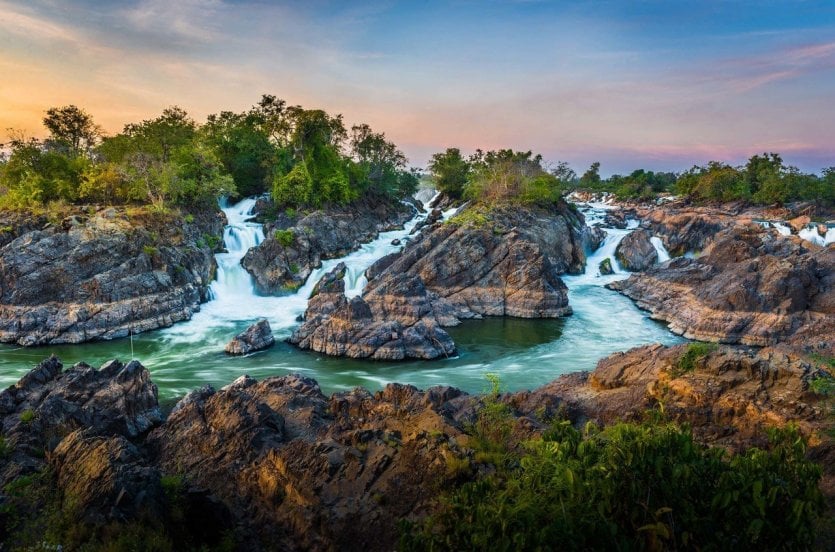
Visiting Laos is discovering a land of contrasts where landscapes and cultures vary according to the region. Along the Mekong River, mountains, waterfalls and a thick tropical forest are visible to visitors. A country of one million elephants, Laos enjoys a preserved nature and an endemic fauna including pachyderms, antelopes and very rare freshwater dolphins. On the cultural side, it is a spiritual destination of choice: sacred temples are of incomparable splendour and bear witness to a thousand-year history. For a guaranteed change of scenery, here are our 10 must-see attractions in Laos
The temple of Wat Phou, cradle of Khmer civilization

The temple of Wat Phou, literally the temple of the mountain, is located in the south of Laos, at the foot of the sacred mountain Bassac. Inscribed on the UNESCO World Heritage List, it is one of the most important testimonies of Khmer pre-civilization, even older than Angkor, the famous Cambodian site. Blended harmoniously into a lush natural setting, it forms one of the country's major sites
Luang Prabang, a jewel of Laos

Between its French colonial houses and Buddhist temples, Luang Prabang reflects the history of Laos. Formerly the country's capital, it is now a UNESCO World Heritage Site. To visit it, you must learn to live at your own pace and attend, before sunrise, the monks' almsgiving ceremony. Then, we will go from temple to temple, from War Xieng Mouane to Wat Sensoukaram, to immerse ourselves in the spiritual atmosphere that reigns in the city
The mysterious cave of Kong Lo

Laos has many caves, mysterious or sacred. Located in the Hin Boun forest, south of Ventiane, Kong Lo Cave is certainly one of the most impressive. It is best to visit it during the dry period, between November and April, as it is crossed by the Nam Hin Bun River and can be reached by canoe. Inside, in near darkness, stalactites and stalagmites are revealed by the light of the lamp
Swimming in Kuang Si Falls

Accessible in 45 minutes from Luang Prabang, Kuang Si Falls are the largest in the region. The main waterfall, 50 m high, flows into pleasant natural pools where turquoise water invites you to swim. Located in a national park, this bucolic site is nestled in the heart of a lush tropical forest. Not far away is a conservation camp for the endangered Asian black bear
Vientiane, a charming capital city

Vientiane is located on the left bank of the Mekong River, just opposite Thailand. Singular for its peaceful atmosphere and its human-sized dimensions, it contrasts sharply with the frenetic capitals of neighbouring countries. If the Pha That Luang is its main monument of interest, the many temples in the image of Vat Sisakhet are also very beautiful visits. To enjoy the sunset, a stroll along the banks of the Mekong River is a must here
Taste delicious Laotian specialities

A trip to Laos may awaken your taste buds! Here, as everywhere in Asia, it is possible to eat at any time thanks to the small shops offering snacks of all kinds. Among the specialities, we melt for khao lam, a sticky rice cooked in coconut milk that we taste in a bamboo stem. In Luang Prabang, you can taste the fried seaweed from the Mekong accompanied by a very spicy chilli jam: tieo bong
The Pha That Luang, a national monument

Emblem of Laos, the origin of this stupa dates back to the 3rd century BC when the missionaries of Asoka, an Indian emperor, brought to Vientiane a fragment of the iliac bone of Buddha. The imposing monument that we admire today was built in 1566, it is covered with 500 kg of gold leaf and rises to 45 m in height. Every year, during the stupas festival in November, the monument welcomes many faithful and monks from all over the country
Pak Ou Caves, a spiritual step

Located two hours by boat from Luang Prabang, the Pak Ou caves are holy and revered places for several thousand years. Decorated with hundreds of Buddha statues, Tham Ting and Tham Theung - the two caves - are true spiritual sanctuaries nestled in limestone cliffs. Not far from the site, the village of Ban Xang Hai is also worth seeing, it is famous for its wine production
Discover the 4000 islands

From the islands to Laos when the country has no access to the sea? Yes, and there are 4,000 of them, nestled in the middle of the Mekong! They form an archipelago called Si Phan Don. Some are miniature and disappear during the wet season, others like Don Khong are a prime stopover to discover a typical and bucolic landscape. The ideal is to rent a bungalow for a relaxing stay, to the rhythm of the river
Bokeo Nature Reserve

Located in the province of the same name, in northwestern Laos, Bokeo Nature Reserve covers 123,000 hectares of tropical forest. Its main mission is to safeguard white-cheeked gibbons, an endangered species. Eco-tourism has developed in the nature reserve thanks to the "gibbon experience": wildlife observation, zip line and overnight in a cabin overlooking the jungle, it is the ideal way to combine discovery of the region with thrills!


